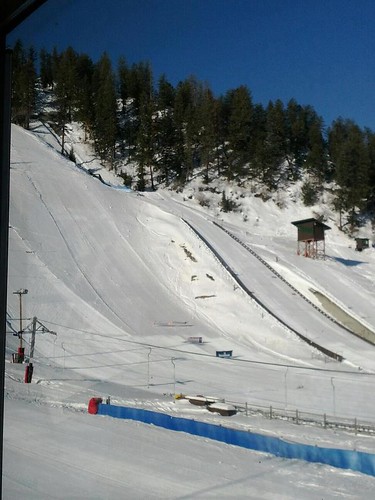Steamboat History Full of Western Lore, Pioneering Spirit
As Steamboat Ski resort celebrates more than five decades of world class skiing and snowboarding, it’s the history behind the place known as Ski Town, U.S.A.® that gives the town its unique character.
Steamboat’s history goes back as early as the 14th century when it is believed that the nomadic Ute Indians spent summers in the Yampa Valley. The Utes roamed the vast lands alone until the 1800s, when early settlers ventured into the valley.
Three French fur trappers traveling down the Yampa River are said to have named Steamboat Springs in 1865. One man heard a chugging sound like that of a paddle wheel steamer. The men hurried toward the sound and found it to be a bubbling mineral spring. The numerous springs around Steamboat are still popular today as a source of relaxation and are rumored to have medicinal benefits.
Steamboat Springs’ first permanent settler was James Harvey Crawford, who discovered the Yampa Valley region while on a hunting trip along the Gore Trail in fall 1874. Crawford staked a homestead claim during this trip and moved to Steamboat Springs the following year with his family.
Stories about the beauty of the Yampa Valley spread, and other families relocated to the area. Among the early pioneers were prominent Missourians Perry A. Burgess and William H. Walton. Along with Crawford and a few others, they entered preemption laws for the town site known as Steamboat Springs. Each took 160 acres and registered a homestead, forming the first community.
The first major catalyst to growth came in summer 1883, when H. H. Suttle opened a sawmill. With the capacity to produce logs for homes and stores, further community development was assured. One of the first businesses to open was the Steamboat Pilot newspaper, which printed its first edition on July 31, 1885. By 1886, the town business district also included a general store, post office and hotel.
Origins of skiing in Steamboat: Communication with the outside world was difficult due to long winters and poor road conditions. On  snowshoes and skis, mail carriers delivered letters and parcels. Faced with mountain passes and the prospect of settling where winter lasts six months and averages nearly 30 feet of snow, pioneers quickly learned to travel the same way.
snowshoes and skis, mail carriers delivered letters and parcels. Faced with mountain passes and the prospect of settling where winter lasts six months and averages nearly 30 feet of snow, pioneers quickly learned to travel the same way.
In the early 1900s, the same hardy settlers who battled winters to survive began turning the hills of Routt County into a winter playground. The change accelerated with the help of Norwegian Carl Howelsen, who arrived in Steamboat Springs in 1912. Soon after his arrival, Howelsen was ski jumping off a wooden platform in Strawberry Park and teaching the sport to local youngsters.
In 1913, Howelsen organized the first Winter Carnival and jumping competitions. During the 1917 Winter Carnival, Steamboat Springs honored the man who transformed skiing from a means of transportation to a sport by naming the ski slope Howelsen Hill.
As skiing grew more popular, adventurous downhillers sought new hills to test their abilities. When Rabbit Ears Pass opened to winter traffic in 1938, the Forest Service cut two runs down the back slopes of the pass to the Valley View Lodge. For the next few years, numerous Winter Carnival events took place on these hills.
A ski resort is born: In 1955, Jim Temple, son of a local ranching family, spearheaded the development of Steamboat Ski Area in response to the growing popularity of the sport, and the new hill opened in 1961 with one Poma lift, the Cub Claw, and $2 lift tickets.
The ski area did not open for the 1961/62 season due to the inability of a lift manufacturer to complete an order for a double chairlift. Storm Mountain officially reopened January 12, 1963, with a double chairlift and an A-frame warming house.
The day’s cash receipts were $13.75, and the temperature hovered at -25 degrees F. The two years following were profitable for the ski area, which helped in gaining permits from the Forest Service to expand the area.
Steamboat lost its favorite son when hometown Olympic skier Buddy Werner was killed in an avalanche in Switzerland on April 12, 1964. Storm Mountain was renamed Mount Werner in his honor.
By the end of the decade, Mount Werner had five new chairlifts, a modern restaurant facility atop Thunderhead Peak, ski patrol buildings, a nursery and numerous maintenance and snow vehicles. This million-dollar building boom generated excitement and development, making tourism a prominent part of the local economy.
The 1st International Winter Special Olympics were held on Headwall during February 1977. The event brought athletes from around the world together for four days of competition. Special guests included Olympic Gold Medalist Bruce Jenner, Colorado Governor Richard Lamm, Ethel Kennedy, Eunice Shriver and Steamboat Director of Skiing Billy Kidd. In addition, Kidd played host at Steamboat to the first Jimmie Heuga Express for MS in 1986, starting a tradition that has spread to resorts across the country.
Steamboat illuminated a new tradition when night skiing and riding premiered on December 20, 2014, utilizing Snow-Bright Lighting, a new technology developed by Ultra-Tech Lighting. Spread across 85 light towers with more than 375 full-color spectrum lights, the system employs a comprehensive line of magnetic induction lighting specifically tailored to address the complexities and unique requirements of illuminating snow in all its varieties while minimizing glare and reflected light. Roughly 1,100 vertical feet of terrain off the Christie Peak Express chairlift is available on five trails including Sitz, See Me, Vogue, Stampede and Lil’ Rodeo Terrain Park.
Ownership of the ski resort changed several times in the 1970s and ’80s. Previous resort owners include LTV Recreational Development, Inc. (1969-1979); Northwest Colorado Ski Corporation spearheaded by Martin Hart (1979-1989); and Kamori International (1989-1997). Steamboat was purchased by American Skiing Company during the 1997/98 season. In March 2007, Intrawest ULC (www.intrawest.com), a world leader in experiential destination resorts, acquired Steamboat Ski & Resort Corporation. Including Steamboat, Intrawest has a network of resorts at North America’s most popular mountain destinations including Blue Mountain, Snowshoe, Stratton, Tremblant, Winter Park and Canadian Mountain Holidays, the largest heli-skiing operation in the world.
Ski Town, U.S.A.®: Steamboat-Ski Town, U.S.A.® was founded by hardworking, friendly individuals and families that enjoyed making turns through the endless deep powder of Storm Mountain and the Yampa Valley. Members of the Werner, Fetcher, Temple, Crawford, Perry, Wren and Nash families as well as Billy Kidd, Moose Barrows, Nelson Carmichael and a plethora of other Steamboat Olympians can still be found enjoying all that Mount Werner has to offer, including its legendary Champagne Powder® snow.
Many things have changed throughout Steamboat’s history, but one has remained steadfastly constant throughout the past five decades: its legendary Champagne Powder snow. It’s always light, dry and plentiful! And, after more than 50 years, you still can’t get Billy, Nelson, Moose or pioneering founders to tell you where their favorite powder stashes are located.
Since its humble start, Steamboat Ski Resort has grown into one of the premier resorts in the world offering 18 lifts, 165 trails and more than a dozen on-mountain restaurant facilities, all spread over 2,965 acres/1,200 hectares.
When Carl Howelsen introduced recreational skiing to Steamboat Springs in 1913, he could never have realized the tradition he was starting. Steamboat has produced more winter Olympians than any other town in North America — a record 88 and counting.
Perhaps the town’s Olympic heritage is due to the fact the community not only allows the kids to get out of school for a race, they encourage it. Perhaps it’s because of one of the largest winter sports clubs in the United States: the Steamboat Springs Winter Sports Club. Whatever the reason, Steamboat is sure to always remain Ski Town, U.S.A.(R)
Steamboat By the Numbers:
| Resort official opening: Jan. 12, 1963 |
| Terrain: 2,965 acres/1,200 hectares |
| Average snowfall: 336 inches/853cm (10-year average) |
| Restaurants and bars: 100+ |
| Winter season: Nov. 22, 2017, to April 15, 2018 |
| Tree terrain: 1,790 acres/724 hectares or 61% |
| Snowmaking: 375 acres/152 hectares |
| Bed base: 19,757 pillows, 8,902 within 300 yards of base |
| Elevations:
Downtown Steamboat………………………….. 6,695 feet……………………………………….. 2,040 meters Ski area base………………………………………… 6,900 feet………………………………………. 2,103 meters Christie Peak summit…………………………… 8,015 feet……………………………………….. 2,444 meters Thunderhead/mid-mountain………………… 9,080 feet……………………………………… 2,768 meters Summit/Mount Werner……………………… 10,568 feet……………………………………….. 3,221 meters Vertical drop………………………………………… 3,668 feet………………………………………. 1,118 meters |
|
| Trail system: | 165 named trails |
| Trail classification: | 14% easier |
| 42% more difficult | |
| 44% most difficult | |
| Longest run: | Why Not, more than 3 miles/4.8 kms |
| Best tree runs: | Length | Vertical | Percent |
| Shadows | 4,600 | 1,850 | 40.2% |
| Closet | 3,600 | 1,547 | 43.0% |
| Twilight | 2,560 | 900 | 35.2% |
| Bar UE Lift Line | 2,600 | 745 | 28.7% |
| Triangle 3 | 2,300 | 690 | 29.2% |
| Lift system: | Gondola (8-passenger) | 1 |
| High-speed six | 1 | |
| High-speed quad | 6 | |
| Triple chairlift | 5 | |
| Double chairlift | 4 | |
| Surface lifts | 1 | |
| Total | 18 | |
| Uphill capacity: | 41,505 per hour | |
| Terrain parks: | Terrain parks | 4 |
| Halfpipes | 1 | |
| Mini halfpipes | 1 | |
| Night skiing | Ultra-Tech™ Lighting | |
| Lifts | 1 | |
| Trails | 5 | |
| Terrain parls | 1 | |
| Light poles | 87 | |
| Vertical | 1,100′ | |
| Steepest trails: | Percent |
| Chute Two | 71.4% |
| Chute One | 66.7% |
| Chute Three | 61.8% |
| The Ridge | 54.2% |
| Mother Nature | 50% |
| North St. Pat’s | 50% |
| Christmas Tree Bowl | 46.3% |
| Concentration | 45.6% |
| Oops | 45.5% |
| Twister | 44.5% |
| Closet | 43.0% |
| Vertigo | 43.0% |



